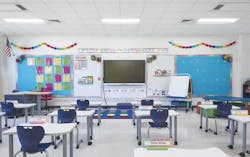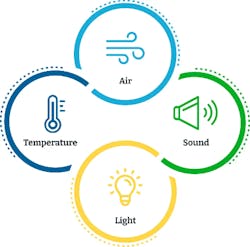The past two years have brought health and air quality to the forefront as the top concern in every aspect of life; at home, at work, and at school. Air quality, noise levels, light, aesthetics, sustainable materials, and other factors all play a role in determining how healthy any space is and directly impacts how well students perform and feel in the classroom.
Improved Indoor Air Quality (IAQ) benefits
Did you know? According to the Harvard Healthy Buildings Program, by the time children graduate from high school, they will have spent an estimated 15,600 hours in school. That daunting fact alone makes it extremely important for the interior of schools to have the highest quality air. Benefits of improved IAQ include:
- Higher overall attendance: poor indoor air quality and indoor pollutants lead to 14 million missed days of school per year. The majority of a school's operating budget is directly dependent on attendance, so even a small increase can significantly boost the operating budget.
- Improved student performance: numerous studies show a direct correlation between a school’s physical condition and student performance.
- Reduced operating costs: School districts can save 20-40% on annual utility costs by applying high performance design concepts.
Ceilings and IAQ
Research from the World Health Organization (WHO) suggests environments heavily populated with poor or insufficient air flow raises infection rates. The WHO further encourages good environmental ventilation in all closed settings.
That's where the ceiling becomes so important. A suspended ceiling allows for the technology needed to create a healthier environment. The most notable of those solutions is that suspended ceilings can control air flow within a room and block any air leakage from inside or outside of it. When a gasket is placed between the ceiling tile and grid, it forms a tight seal and prevents the spread of bacteria and other viruses into the area above the tiles and into other spaces. Armstrong Ceilings’ AIRASSURE ceiling tiles already have the gasket built into the tile and it seals to the most common suspended grid types. In addition to helping contain air, the tighter seal helps reduce leaks and can increase the efficiency of HVAC filtration. These tiles also have the best acoustic performance, high light reflectance, and are made of sustainable materials.
An even more efficient system would allow more air, and potential contaminants, to be exhausted up and out of the room (instead of across it) and into filters capturing and cleaning the air of pathogens. In-ceiling filter solution, such as the VIDASHIELD UV24 Air Purification System, proves to be more efficient, safe, and effective than other purification systems located within the room.
Other Elements of a Healthy Space & Ceilings
We define a healthy space as an ecosystem that is made up of elements working together to form a healthier environment. The elements are air, sound, light, and temperature. In order to create the healthiest space, all four need to work in unison.
- Air - ceilings can work as a protector that contains and cleans against the spread of infectious aerosols, helping to improve indoor air quality.
- Sound - acoustical ceiling tiles help improve comprehension and enhance concentration, both of which are especially important in the classroom.
- Light - light reflecting ceilings bring the feeling of the outdoors into interior spaces through a balance of natural and supplemental light. Studies show that creating more natural light makes spaces brighter with happier students, while also resulting in reduced energy consumption.
- Temperature - ceilings can help maintain uniform temperature levels, reduce humidity levels, and increase HVAC efficiency.
Ensuring your school can address all of these elements has never been more attainable. Thanks to the Elementary and Secondary School Emergency Relief Fund (ESSER), established as part of the Education Stabilization Fund in the CARES Act, elementary and secondary schools have access to additional funds to help address the impact of COVID-19. ESSER funds are allowed to be used on many different areas within schools, the most notable improving air quality in school buildings, as well as making repairs to reduce the risk of viral transmission.
Case Studies
Here are a couple examples of schools that have successfully addressed their indoor air quality:
- Neff elementary, located in Lancaster PA, was able to increase their indoor air quality.
- St. Francis Xavier School, an elementary school in Illinois, improved the airflow AND noise in their cafeteria.
The IEQ of any school directly impacts the success of students and staff. Students need a healthy space to reach their full potential and to maximize the amount of days in person. Creating the optimal environment school facilities starts at the top.
Who we are
We are Kanopi by Armstrong Ceilings, the direct-to-customer branch of Armstrong World Industries, Inc. (AWI), a leader in the design and manufacture of innovative ceiling, wall, and suspension systems. We provide healthy, acoustical ceiling and wall solutions and are committed to assisting all of our customers selecting the right products for their space. Additionally, we are the only building supplier that allows for our customers to buy the material, get it sent to their business or place of work, and use our nationwide ceiling installation team.
Connect with our team of experts to find out if a new ceiling is right for your school, get recommendations, and find out how to have it installed.


